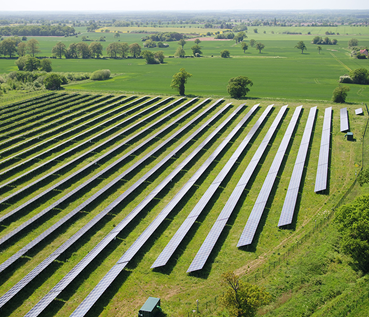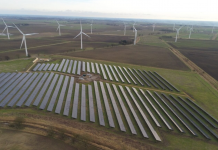Britain’s solar industry reacted with alarm this morning and a stinging rebuttal to the Truss government’s reported desire to ban lower grade farmland for new solar farms, in effect halting the roll-out of grid-scale PV in England.
Trade umbrella group Solar Energy UK accused novice farming secretary of state Ranil Jayawardena of signing up for his boss’s fabled “anti-growth coalition”.
This morning the Guardian reported that Jayawardena has requested his DEFRA officials to extend its “best and most versatile” (BMV) classification of farming land to include the lower 3b category. The effect would be to exclude new PV from most English farmland, thus torpedoing England’s pipeline of solar farms awaiting planning consent.
The entire UK pipeline of solar projects either before planners now or approaching submission is estimated at around £17 billion of committed investment.
Farmland is loosely graded in quality from 1 to 5, the worst. “Best and most versatile” land, or BMV, currently includes grades 1 to 3a, but it excludes 3b. As much as 58% of England’s defined fields, the Guardian reports, fall into the 3b category.
Appointed to his first cabinet post by Truss last month, in April Jayawardena was among objectors who successfully defeated a proposed 200-acre PV farm in his own rural constituency, The Energyst can reveal. A planning manager at the applicant developer, Enso Energy told this publication today that Jayawardena as MP never engaged with them.
Best practice guidelines
The Johnson’s administration’s energy security strategy said little about solar, but re-admitted the technology to bid for grid-scale Contracts for Difference. Labour backs industry goals of tripling current solar UK capacity, reaching 40GW by 2030.
Newby cabinet member Jayawardena is believed to share his boss’s belief that solar farms impede food production and his boss’s growth agenda. During the Conservatives’ leadership hustings, Truss attacked the ‘paraphenalia’ of solar generation on farmland.
The industry fiercely rejects the ministers’ prejudice.
The first of Solar Energy UK’s eleven long-standing ‘best practice’ principles of solar farm development commits developers to site PV farms on “non-agricultural land or land which is of lower agricultural quality where available”.
The non-binding guidelines commit developers to deliver “multi-functional land use, co-located with agriculture and/or nature recovery projects”.
This morning the industry launched a broadside, rebutting DEFRA’s rumoured attack.
Such a move by DEFRA “would have the effect of tilting the planning system against one of the very cheapest and greenest sources of energy available”, Solar Energy UK said in a statement.
It would be motivated by “false and baseless claims” that solar farms threaten the UK’s food security, the lobbyists asserted. Last month SEUK published its own assessment of PV farms on UK food production.
Popular solar
“Solar farms defend global and UK food supply because they address climate change, which is the single biggest threat to UK food security, according to Jayawardena’s own department Defra”, today’s statement goes on.
“Solar keeps farmers in business, providing a stable source of income in uncertain economic times, caused in the first place by the UK’s continued reliance on fossil fuels”, it said, citing farmers’ defence of PV deployment, made by NFU vice president Tom Bradshaw in August.
Britain’s fossil fuel dependence was also the primary reason consumers around the country are facing a cost-of-living crisis, said Solar Energy UK.
More than 2.2GW of solar capacity was procured in this year’s latest round of the Contracts for Difference scheme, the government’s auction system for future clean generation, at some of the cheapest prices yet, Solar Energy UK point out.
The technology’s recent surge, backed by its status as Britain’s most popular form of clean power, means it could supply 17% of annual UK electricity demand by 2035, supporting 60,000 jobs, SEUK claim.
“Anti-growth coalition”
Chris Hewett, Solar Energy UK’s boss, said ““UK solar is alarmed by attempts to put major planning rules in the way of cheap, homegrown energy. Solar power is the answer to so many needs and policy demands: it will cut energy bills, deliver energy security, boost growth and help rural economies.
“Ranil Jayawardena’s opposition to solar farms must surely make him part of the anti-growth coalition,” the industry leader jibed.
In April the new DEFRA secretary was among objectors to developer Enso Energy’s rejected bid to erect a PV farm on 200 acres at Bramley in his NE Hampshire constituency. The rural seat is among Britain’s safest, returning the former banker to Westminster in December 2019 with a 20,200 majority.
Enso’s planning manager Simon Chamberlain told The Energyst this morning that he did not recall the MP, then a junior trade minister, contacting the developers directly about the proposed Bramley development.
It is believed that DEFRA have shared no documented proposals with the farmers’ union on Jayawardena’s reported land re-classification.
NFU Deputy President Tom Bradshaw said this morning: “Renewable energy production is a core part of the NFU’s net zero plan and solar projects often offer a good diversification option for farmers.
“However, there is a need to strike a balance between food security and climate ambitions. It is important that large scale solar farm development is located on lower quality agricultural land, avoiding the most productive and versatile soils.
“Utilising roofs and farm buildings for solar should also be incentivised as it delivers a sustainable method of energy production while avoiding any land use conflict,” the NFU deputy concluded.
Any land re-classification affecting future solar buildout is unlikely to be achieved by DEFRA alone. As parties to energy development, D-BEIS, Department of Housing and Levelling UP, plus HM Treasury would likely be required to coordinate management of its implications, including in planning law.





Is this really a problem when 95% of large industrial buildings are still without solar? I suggest we cover these roofs first before considering whether we need to cover land.
Readers of The Energyst will be grateful for your authority for that “95%” number, Mr Perfect. And your apparent serial approach of “first one solution completed, then a second addressed” is strikingly similar to the evident fallacy that the global community should take no action in reversing the climate catastrophe, before the Chinese Communist Party have been persuaded to cease building coal-fired power stations.
Alban, thanks for testing my comments, to which I owe you a response. The 95% is very much a ballpark figure using statements made by Solar Energy UK, the solar trade association. Their website states they have an ambition for “40 GW of solar across the UK by 2030”. They say there are already around “two gigawatts of commercial and industrial rooftop solar system capacity installed in the UK”. Hence my 95% ballpark figure of availability. That’s obviously an underestimate as 40 GW is not the capacity available from the remaining roof area, just their “ambition” for 2030. Nevertheless it is an order of magnitude estimate that shows we still have plenty of industrial roof area to cover with solar before we need to look at covering more of our land. It’s not a serial approach, just a matter of priorities. That is to put solar on commercial roof space first, that is otherwise unused, before putting solar on land, that has many other uses.
Let me throw another stone into the pond. Consider the mess that the UK Government has made of the planning system.
Perhaps I am not surprised that hundreds of new homes are being given planning approval, overriding hundreds of local objections, but solar panels are not compulsory..
Yet many of these homes are being heated by heat pumps.
And EV charging points are not being offered.
All three of these issues affect the additional load to be absorbed by the power supply network on site and feeding the site